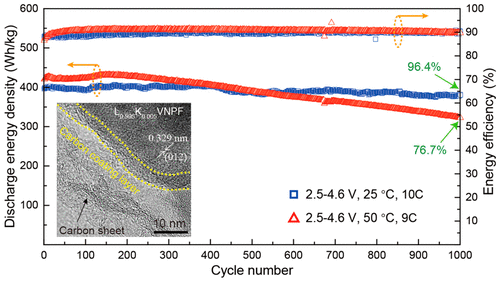当前位置:
X-MOL 学术
›
ACS Appl. Energy Mater.
›
论文详情
Our official English website, www.x-mol.net, welcomes your
feedback! (Note: you will need to create a separate account there.)
Elevated Energy Density and Cyclic Stability of LiVPO4F Cathode Material for High-rate Lithium Ion Batteries
ACS Applied Energy Materials ( IF 5.4 ) Pub Date : 2020-04-07 , DOI: 10.1021/acsaem.0c00081 Xu Xue 1, 2 , Youlong Xu 1, 2 , Xiaoning Ma 1, 2
ACS Applied Energy Materials ( IF 5.4 ) Pub Date : 2020-04-07 , DOI: 10.1021/acsaem.0c00081 Xu Xue 1, 2 , Youlong Xu 1, 2 , Xiaoning Ma 1, 2
Affiliation

|
Simultaneous realization of superior energy density and cyclic stability of a cathode material under high rate is imperative for practical applications in rechargeable lithium-ion batteries (LIBs). In the present work, the effects of a marginal amount of K substitution of Li on the electrochemical properties of the Li1–xKxV0.98Nb0.02PO4F@C (L1–xKxVNPF@C, x = 0–0.01) cathode materials are investigated. As a result, K substitution of Li has a great influence on the electronic conductivities, ionic conductivities, charge transfer resistances, and Li+ diffusion coefficients of the L1–xKxVNPF@C (x = 0.003–0.01) cathode materials. Substantially improved discharge capacities and energy densities are observed in the L1–xKxVNPF@C (x = 0.003–0.01) cathodes under high charge/discharge current densities of 0.4–1 A g–1. In particular, because of the highest Li+ conductivity and diffusivity, the L0.995K0.005VNPF@C cathode exhibits an optimal electrochemical performance at both 25 and 50 °C. It delivers a high discharge capacity of 101 mA h g–1 at 10 C with a capacity retention of 95.3% after 1000 cycles at 25 °C. Correspondingly, the initial discharge energy density and energy retention is 396.2 Wh kg–1 and 96.4%, respectively. Even evaluated at 9 C and 50 °C, the initial discharge energy density and energy retention after 500 cycles is 420.6 Wh kg–1 and 92.9%, respectively, which is highly promising for practical applications. The present work may provide a valuable guidance to elevate the energy density and cyclic stability of a cathode material for high-rate LIBs.
中文翻译:

用于高速率锂离子电池的LiVPO 4 F正极材料的高能量密度和循环稳定性
在可充电锂离子电池(LIB)的实际应用中,同时需要在高倍率下同时实现优异的能量密度和正极材料的循环稳定性。在目前的工作中,少量的K取代Li对Li 1– x K x V 0.98 Nb 0.02 PO 4 F @ C(L 1– x K x VNPF @ C,x = 0-0.01)阴极材料进行了研究。结果,Li的K取代对L的电子电导率,离子电导率,电荷转移电阻和Li +扩散系数有很大影响。1– x K x VNPF @ C(x = 0.003–0.01)阴极材料。在高充电/放电电流密度为0.4-1 A g -1的情况下,在L 1– x K x VNPF @ C(x = 0.003-0.01)阴极中观察到了显着改善的放电容量和能量密度。特别是,由于最高的Li +电导率和扩散率,L 0.995 K 0.005 VNPF @ C阴极在25和50°C时均表现出最佳的电化学性能。它具有101 mA hg –1的高放电容量在25°C下经过1000次循环后,在10 C下保持95.3%的容量保持率。相应地,初始放电能量密度和能量保持率分别为396.2 Wh kg –1和96.4%。即使在9 C和50°C下进行评估,500次循环后的初始放电能量密度和能量保持率分别为420.6 Wh kg –1和92.9%,这在实际应用中非常有前途。本工作可以为提高用于高速率LIB的阴极材料的能量密度和循环稳定性提供有价值的指导。
更新日期:2020-04-07
中文翻译:

用于高速率锂离子电池的LiVPO 4 F正极材料的高能量密度和循环稳定性
在可充电锂离子电池(LIB)的实际应用中,同时需要在高倍率下同时实现优异的能量密度和正极材料的循环稳定性。在目前的工作中,少量的K取代Li对Li 1– x K x V 0.98 Nb 0.02 PO 4 F @ C(L 1– x K x VNPF @ C,x = 0-0.01)阴极材料进行了研究。结果,Li的K取代对L的电子电导率,离子电导率,电荷转移电阻和Li +扩散系数有很大影响。1– x K x VNPF @ C(x = 0.003–0.01)阴极材料。在高充电/放电电流密度为0.4-1 A g -1的情况下,在L 1– x K x VNPF @ C(x = 0.003-0.01)阴极中观察到了显着改善的放电容量和能量密度。特别是,由于最高的Li +电导率和扩散率,L 0.995 K 0.005 VNPF @ C阴极在25和50°C时均表现出最佳的电化学性能。它具有101 mA hg –1的高放电容量在25°C下经过1000次循环后,在10 C下保持95.3%的容量保持率。相应地,初始放电能量密度和能量保持率分别为396.2 Wh kg –1和96.4%。即使在9 C和50°C下进行评估,500次循环后的初始放电能量密度和能量保持率分别为420.6 Wh kg –1和92.9%,这在实际应用中非常有前途。本工作可以为提高用于高速率LIB的阴极材料的能量密度和循环稳定性提供有价值的指导。


















































 京公网安备 11010802027423号
京公网安备 11010802027423号